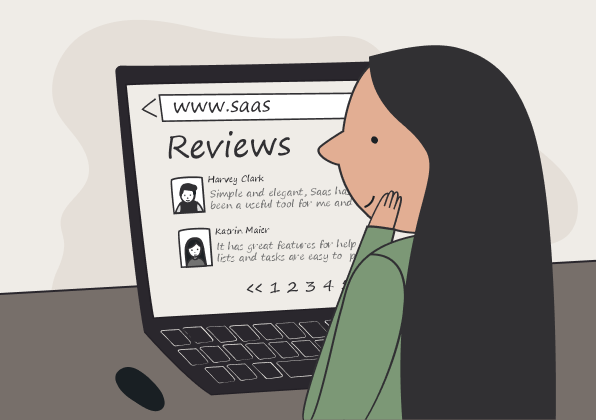Customer touchpoints are the well-worn pages of a brand's novel in the grand library of different industries. These intimate, dog-eared corners tell the story of connections forged and narratives unfolding.
They are the carefully penned paragraphs that capture attention, the bold chapter titles that guide the reader through the brand's tale. Much like a riveting book, the journey through customer touchpoints is an immersive customer experience where every page turn reveals a new layer, a fresh insight, and an opportunity for the reader to be spellbound.
So, let us embark on a literary expedition where we decode the plot twists of customer touchpoint analysis, explore the eloquence of their examples, and flip through the engaging chapters of customer interactions.
Turn the page, and let the narrative unfold.
Contents
What is a customer touchpoint?

A customer touchpoint boils down to the following: it's a moment when you, as a customer, interact with a brand. Simple, right?
These interactions happen everywhere, from the first time you hear about a brand to when you're on their website or buying something in a store. Essentially, it's the journey you go through with a brand, starting from the first encounter to the final purchase and what happens afterward.
Read also: The difference between customer touchpoints and channels.
Why are customer touchpoints important?

Recognizing and optimizing these touchpoints is crucial for businesses for different reasons:
Higher customer retention
Strategic touchpoint management actively contributes to customer retention by weaving positive experiences, resolving issues promptly, personalizing interactions, optimizing the customer journey, building emotional connections, maintaining brand consistency, and strategically implementing loyalty programs.
Imagine this: An online store that sells coffee beans messed up and sent the wrong type to a customer. When the customer complained, the store not only replaced the coffee but also threw in some sweets as an apology. They even asked how everything was and if it all tasted good. Despite the initial hiccup, the customer ended up happy and kept on shopping from the store. Plus, they started telling their friends about it.
Brand impression
How you feel about a brand often comes from these moments. If everything goes well, you trust and like the brand. But if something goes wrong, it can make you think twice. Such touchpoints are called moments of truth; they are critical junctures in the customer journey where high expectations meet outcomes that create a lasting impression.
These pivotal moments significantly influence whether a customer becomes a loyal advocate for the brand or decides to switch to a competitor.
Picture this: A coffee joint that always serves fantastic brews, sports-friendly staff, and oozes a comfy vibe. It gives customers the impression that it's a reliable, top-notch spot. But for some folks, their moment of truth isn't the chill atmosphere or the barista's grin.
It's more about how well they wrap up those pastries to-go or if the coffee joint is open when hustling to work.
Understanding the customer journey
By examining these moments, businesses can understand what customers go through—the good parts, the tricky bits, and what they like. This helps companies shape how they do things and improve customer experience.
It's worth adding that a smooth journey not only enhances the customer experience but also helps clarify responsibility within the team, making teamwork more efficient. That means the team can work together more effectively, knowing who's accountable for each aspect and ensuring a well-coordinated effort.
See this happening: An airline considers your entire customer journey, from booking a ticket to giving feedback after your trip. They leverage customer reviews to pinpoint areas that need improvement and enhance the convenience of the entire process. This helps them fix issues more effectively and ensures a smoother, more personalized experience for future travelers.

Take, for example, this company that caught on to the fact that folks in the back rows weren't getting much choice when it came to in-flight meals, and it was irking passengers. So, they rolled out a new deal—now you can pick your grub when you snag your ticket. They even started putting together meal combos tailored to what passengers wanted. It's a smart move that keeps people happy and amplifies the company's fan base.
Spotting and fixing issues
Businesses can figure out what needs fixing by determining customer experience at this or that touchpoint. It could be making things faster, improving products, or just being better at helping customers.
See the improvement: A tech company listens to customer questions and issues. They noticed a trend where customers often faced delays in product deliveries, leading to dissatisfaction.
To address this, the company revamped its logistics system, partnering with a more efficient courier service and implementing real-time shipment tracking. This move made deliveries faster and provided customers with transparency and peace of mind.
Getting feedback and data
These moments are also chances for businesses to learn. By asking customers what they think, businesses can make smarter choices.
Think about this scenario: A food delivery app team frequently seeks user feedback to enhance its service. After a user gets an order, they send a quick survey asking about their experience—the delivery speed, food quality, and overall satisfaction. This real-time feedback loop allows them to understand customer preferences and concerns.
For instance, if users express a desire for more restaurant choices in a particular area, the company can strategically expand its partnerships. Alternatively, if customers consistently praise the app's user-friendly interface, the development team knows they're on the right track.
Customer touchpoint examples

Let's explore some common customer touchpoints and why they matter:
Website visiting
A brand's website is the initial digital touchpoint in the customer journey, serving as the book's first chapter, setting the tone for the customer's perception.
What would you choose as a customer?
- A software developer, Leo, visits a SaaS provider's website looking for API documentation but finds the site cluttered and the search function unhelpful. Frustration mounts as pop-ups disrupt his navigation, leading to a negative first impression that deters him from considering their services further.
- Leo, a software developer, visits a SaaS provider's website to find API documentation. He's immediately directed to a well-organized 'Developers' section, where comprehensive and easy-to-follow documentation awaits. A convenient live chat option lets him quickly clarify a question, enhancing his experience and confirming his interest in the company's offerings.
Engaging on social media
Interacting with a brand on social media is a dynamic touchpoint where customers can engage in real-time conversations. This engagement, whether through direct messages, comments, or content shared in a direct message, provides immediate and personal interaction. It is positioned as a pivotal touchpoint for building community and customer loyalty, often influencing the relational aspect of the customer journey.
What would you choose as a customer?
- Michael, a procurement manager for a hospitality business, inquires about a furniture manufacturer's Instagram post about bulk order discounts. The manufacturer's account quickly responds with a direct message, offering to set up a call to discuss detailed pricing and customizable options for businesses, showcasing their responsive B2B customer service on social media.
- Michael, a procurement manager for a hospitality business, decides to reach out to a furniture manufacturer via Instagram regarding bulk order discounts. After leaving a comment on the manufacturer's post, he receives no response for days. Frustrated, Michael decides to send a direct message to the manufacturer, but the reply she eventually gets is generic and unhelpful. The message directs him to their website for pricing information, showing a lack of interest in catering to her business needs. That leaves him feeling ignored and disappointed with the manufacturer's apparent disregard for personalized customer service on social media.
Getting help from customer service
Reaching out to customer service is a decisive touchpoint that often occurs when a customer is experiencing a problem or needs assistance. The efficiency, empathy, and effectiveness of the support are crucial in determining customer satisfaction and retention.
Positioned at a critical juncture, especially when a customer decides whether to continue using a service or product, excellent customer service can turn a potentially negative experience into a positive one, reinforcing customer loyalty.
What would you choose as a customer?
- Sarah contacts customer support for help with her laptop, hoping for a good experience like others have mentioned. However, when she starts a live chat, the person helping her is slow to respond and seems like they don't care about her problem. After a long wait, the representative gives vague instructions that don't really help with Sarah's issue. Feeling frustrated and unable to fix her problem, Sarah is unhappy and feels like the company doesn't value her, making her view of the company not so great.
- Sarah contacts customer support for a laptop issue and is quickly assisted via live chat. The representative's prompt and helpful service leads to a swift resolution, leaving Sarah with a strong sense of being valued by the brand.
Opening a package
Opening a package is a tactile touchpoint where product presentation and packaging quality directly impact the customer's brand perception. It's an opportunity for a brand to impress and delight the customer through thoughtful presentation and personal touches.

What would you choose as a customer?
- Alex eagerly awaits the arrival of his custom-built keyboard, expecting a personalized and premium experience based on the positive reviews he read. However, when he finally receives the package, he is disappointed to find that the eco-friendly packaging is damaged, and the keyboard inside appears to have been mishandled during shipping. Instead of a handwritten note, there's a generic and hastily written message that conveys a different level of care and attention than promised. The overall unboxing experience falls short of Alex's expectations, leaving him with a sense of dissatisfaction and questioning the quality of the product and the company's commitment to customer experience.
- Alex receives his custom-built keyboard with the company's logo on eco-friendly packaging. Inside, a handwritten note accompanies the well-protected product, making the unboxing experience feel personal and premium.
Receiving emails
Emails are a personal touchpoint where content relevance and tone can significantly influence customer perception and loyalty. An effective email strategy delivers timely, useful, and personalized content to foster a positive connection.
What would you choose as a customer?
- Jordan receives an email from the software company whose product he uses. This time, the content is confusing and poorly written. The message is filled with technical jargon and lacks clarity, making it difficult for Jordan to understand how the new features align with his interests. Instead of feeling informed and valued, he is left frustrated and questioning the company's ability to communicate effectively. The lack of professionalism in the email erodes Jordan's confidence in the software company, making him reconsider his decision to use their services.
- Jordan receives a concise email from the software company whose product he uses, highlighting new features that directly align with the interests he indicated during sign-up. The clear and professional communication reinforces his decision to use their services, feeling informed and valued.
Searching for a product
The experience of searching for products on the shelves is a critical touchpoint that can influence customer satisfaction. Clear signage, well-organized displays, and easily accessible products are crucial to a positive in-store experience.
What would you choose as a customer?
- Mia’s experience in the store highlights several poor examples of touchpoints in a customer journey. From unclear aisle markers to a confusing layout, each of these touchpoints impacts her overall perception of the brand. The disorganized kitchenware section and the lack of price labels further deteriorate her shopping experience, making it stressful and frustrating. These critical touchpoints—store navigation, product organization, and pricing—are essential in ensuring a positive journey. When poorly executed, as in Mia’s case, they create negative impressions and reduce the likelihood of her returning to the store.
- Mia enters a store looking for a specific kitchen gadget. She easily locates the kitchenware section thanks to clear aisle markers. The products are neatly arranged and labeled, making her search quick and stress-free, enhancing her overall shopping experience and impression of the store.
Why it's important: Going to a store is like an adventure. If it's organized, the people are nice, and you find what you want easily, it's like having a great adventure. You'll want to come back for more adventures.

Creating an account
The account creation step is a critical touchpoint where ease and transparency can set the stage for user engagement. As part of the different touchpoints in a customer journey, a straightforward, secure, and user-friendly sign-up process helps build trust and encourages continued use of the app. When integrated with other touchpoints like onboarding and first-time interactions, it forms a seamless customer experience that enhances user satisfaction and long-term loyalty.
What would you choose as a customer?
- Tom downloads a fitness tracking app and immediately faces a lengthy account creation process filled with unnecessary questions and requests for excessive permissions. This invasive and time-consuming setup frustrates Tom, causing him to uninstall the app before even using it in search of a more user-friendly alternative.
- Tom downloads a fitness tracking app and is pleasantly surprised by a streamlined and user-friendly onboarding process. The app requests only essential information, keeping the account creation process quick and hassle-free. Tom appreciates the app's respect for his time and privacy, as it doesn't ask for unnecessary permissions. Impressed by the seamless experience, he easily completes the setup, feeling confident that he made the right choice. This positive onboarding experience encourages Tom to explore the app further and commit to incorporating it into his fitness routine.
Expressing gratitude after purchase
A post-purchase thank you is a touchpoint that can leave a lasting impression of appreciation and value. It's an opportunity for a brand to express gratitude and reinforce a positive customer relationship.
What would you choose as a customer?
- After purchasing a new book online, Raj receives an automated order confirmation email, but it lacks any personal touch or a genuine ‘thank you’. This oversight makes the transaction feel impersonal and transactional, missing the chance to foster a greater connection with Raj.
- After purchasing a new book online, Raj receives an order confirmation email that goes beyond the standard automated message. The email not only provides the necessary details but also includes a personalized message expressing genuine gratitude for his purchase. The tone is warm and friendly, making Raj feel appreciated as a customer. Additionally, the email provides a personalized book recommendation based on Raj's purchase, showing that the company values his interests. This thoughtful touch turns a routine transaction into a positive and memorable experience, fostering a greater connection between Raj and the online bookstore.

Seeing ads
Seeing an advertisement is a touchpoint that can either capture interest and reinforce brand recall or lead to ad fatigue if not executed thoughtfully. Ads should be relevant, engaging, and, ideally, add value to the viewer's experience.
What would you choose as a customer?
- Emma keeps encountering the same Google ad from an online retailer on various websites she visits. The ad is not tailored to her interests and appears too frequently. This situation annoys her and creates a negative association with the brand, making her less likely to click or make a purchase.
- Emma starts noticing personalized and well-tailored ads from her favorite online retailer while browsing various websites. These ads showcase products that align with her interests and preferences, providing a more relevant and enjoyable experience. The frequency of the ads is balanced, and they appear at strategic moments, making them less intrusive. Emma appreciates that the online retailer takes the time to understand her preferences. This positive connection makes her more likely to click ads and explore new products. As a result, she's more engaged with the brand, which increases the chances she'll make a purchase.
How to identify your customer touchpoints?
Now that you know why and understand what it is, here are a few tips on how to identify touchpoints:
- Review your customer journey

What to do: Start by mapping out the entire customer journey from the initial awareness of your brand to the post-purchase phase. Identify key stages, such as research, consideration, purchase, and post-purchase.
Why it helps: Mapping the customer journey visually shows where customers interact with your brand. It also highlights key touchpoints for further analysis. By identifying these crucial moments, you can evaluate each stage for improvements. This ensures a smoother experience and boosts customer satisfaction.
- Utilize customer feedback and surveys
What to do: Actively seek feedback from your customers. Use surveys, interviews, or online reviews to understand their customer experience at different stages of interaction with your brand.
Why it helps: Customer feedback is a goldmine for data that helps to identify touchpoints. It also reveals which interactions left a lasting impression, both positive and negative.
- Track online and offline interactions
What to do: Monitor both online and offline interactions. This includes website visits, social media engagement, in-store experiences, customer service interactions, and any other points where customers interact with your brand.

Why it helps: Monitoring various channels helps identify touchpoints across different platforms. Customers may engage with your brand in multiple ways, and understanding each touchpoint ensures a holistic approach to customer experience.
- Conduct employee interviews
What to do: Talk to your employees who interact directly with customers and gather insights about the touchpoints they consider important. Additionally, conduct interviews with customers to understand their perspectives on their journey with your brand.
Why it helps: Frontline employees often have valuable insights into customer interactions and their experience related to those. Customer interviews provide firsthand accounts of touchpoints that stood out in their experience.
How to improve the customer journey with touchpoints?

Improving the customer journey with touchpoints involves enhancing the overall experience at every interaction, including points of sales. These are critical moments where customers engage with your product or service. Optimizing them is key to driving satisfaction and loyalty.
Strategies for enhancing touchpoints
- As new technologies emerge, points of sales evolve, adding digital payment options, online checkout systems, and self-service kiosks. During unexpected events or crises, you may need to adjust these touchpoints to handle new challenges effectively. For example, offering contactless payments or curbside pickups can help address new customer needs.
- Use customer data to personalize interactions at the point of sale. These interactions can range from addressing customers by name during the transaction to recommending products based on past purchases or preferences. Personalized points of sale interactions enhance customer satisfaction and can increase repeat purchases.

- Solicit feedback at various touchpoints and use it to make informed improvements. Act on both positive and negative feedback to continuously refine the customer experience.
- Implement an omnichannel strategy to ensure a unified customer experience across all channels. The message and experience should be consistent whether a customer interacts with your brand online, in-store, or over the phone. Consistency builds trust and reinforces brand identity. Also, ensure a seamless transition between touchpoints, allowing customers to move effortlessly from one stage to the next.
- Invest in user-friendly design for digital touchpoints, such as websites and apps. Ensure that navigation is intuitive and the overall design enhances the user experience. Consider the optimization of steps your audience has to take to achieve their goals.
- Post-purchase touchpoints are crucial elements of the customer journey that unfold after a customer has completed a purchase. Despite their significance, these touchpoints are often overlooked. Meanwhile, they play a pivotal role in determining whether customers may churn or, conversely, transform into dedicated brand advocates.
Wrapping up
Touchpoints aren't just steps your customers take; they're opportunities. Whether it's a website visit or getting help from customer service, each interaction adds to the customer experience story.
Effective customer touchpoint management allows a brand to forge meaningful connections, leaving a lasting impression that resonates with customers. It's akin to reaching the conclusion of an exceptional book. You understand that the collective experiences woven through these touchpoints truly bring a brand into its audience's memory.
Ready to dig into analyzing touchpoints and the customer journey?





